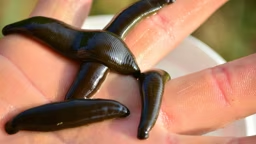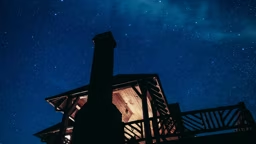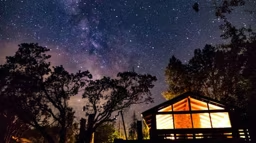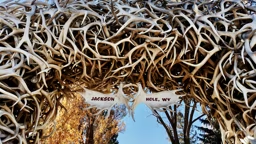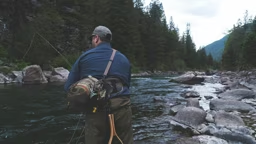Sunrise. On any spring morning, I can stroll away from my cottage to gaze in awe at fog in the valley and freshly budding leaves. Above, I’ll hear the sweet and simple sounds of migrating songbirds as they call back and forth, searching for a place to rest, to find food and water after a long flight.
While I stand watching in my woodlot garden, the birds descend all around, their colors bright, their activities exciting. Warblers, vireos, flycatchers and thrushes flit about in the branches, a pallet of vivid color.
Each tiny bird seems packed with more life than animals a hundred times larger.
I always feel fortunate to witness such a show, but it’s not just luck. This garden holds all of the right ingredients.
Location, location, location. Of course, real estate is an important consideration. And cabin country often provides the perfect canvas upon which to create a garden for birds.
Many urban and suburban homeowners build lush gardens in the middle of relatively sterile landscapes. While such a garden may hold more birds than the surrounding area, that’s not optimum.
The best scenario for attracting birds really is a great garden within a great landscape. If you are already surrounded by a beautiful and wild countryside filled with birds, it’s easy to think your cabin garden will be passed over by the birds you’d like to attract. But a well-planned garden will pull birds into close view.
While I stand watching in my woodlot garden, the birds descend all around, their colors bright, their activities exciting. Warblers, vireos, flycatchers and thrushes flit about in the branches, a pallet of vivid color.
Each tiny bird seems packed with more life than animals a hundred times larger.
I always feel fortunate to witness such a show, but it’s not just luck. This garden holds all of the right ingredients.
Location, location, location. Of course, real estate is an important consideration. And cabin country often provides the perfect canvas upon which to create a garden for birds.
Many urban and suburban homeowners build lush gardens in the middle of relatively sterile landscapes. While such a garden may hold more birds than the surrounding area, that’s not optimum.
The best scenario for attracting birds really is a great garden within a great landscape. If you are already surrounded by a beautiful and wild countryside filled with birds, it’s easy to think your cabin garden will be passed over by the birds you’d like to attract. But a well-planned garden will pull birds into close view.
Be the provider. How is a bird garden different from any other garden? Bird gardens provide for a variety of survival needs, including food, cover, nesting substrate and water.
For plants, think perennials, shrubs and trees. While feeders may provide bird food, there are many beautiful plants that will provide treats for all sorts of birds. Viburnum, dogwoods, plums, currants, sumacs, apples and other woody shrubs and trees add depth to the garden. And in addition to providing seasonal bird treats, they provide sheltering cover.
Raspberries are a real favorite of birds, providing both food and thorny protection. (It should go without saying, raspberries are also great with ice cream for the nearby cabin inhabitants.)
Ideally, bird gardens should provide a mosaic of thickets, flower patches, blossoming trees, bird houses, feeders and watering features. This mix ensures that the landscape will be favored by a variety of birds.
For example:
When planning for such biological diversity, be sure to check with your local plant experts and USDA zone maps for plant hardiness.
For plants, think perennials, shrubs and trees. While feeders may provide bird food, there are many beautiful plants that will provide treats for all sorts of birds. Viburnum, dogwoods, plums, currants, sumacs, apples and other woody shrubs and trees add depth to the garden. And in addition to providing seasonal bird treats, they provide sheltering cover.
Raspberries are a real favorite of birds, providing both food and thorny protection. (It should go without saying, raspberries are also great with ice cream for the nearby cabin inhabitants.)
Ideally, bird gardens should provide a mosaic of thickets, flower patches, blossoming trees, bird houses, feeders and watering features. This mix ensures that the landscape will be favored by a variety of birds.
For example:
- While spruce trees are lovely, a monoculture of spruce trees may attract little more than a few, common species.
- But by adding blossom trees, you attract insect pollinators, and insects attract a variety of very colorful birds.While you’re at it, plant a patch of coneflowers and sunflowers to nourish a goldfinch or two.
- By all means include an open area of lawn near a fence or a young tree. It may become a pouncing place for hungry bluebirds or phoebes, with the fence or tree serving as the hunting perch.
When planning for such biological diversity, be sure to check with your local plant experts and USDA zone maps for plant hardiness.
Tailor-made nesting. Different birds require different nesting substrates. While a house wren may seek out a hole in a dead tree or a hanging bird house, a cactus wren needs a cactus or thorny shrub in which to weave a heavy nest. Cardinals look for dense spruce or cedars. Bluebirds require open space around an east-facing nest box. Some warblers may prefer a plum thicket and orioles may search out older shade trees with supple branches such as maples and cottonwoods.
Research the birds you wish to attract, find out what kinds of nests they require, then plant for those species. You may find your garden contributing to successful bird conservation and a growing avian population.
Flowers for hummingbirds. While the eastern United States is home to only the ruby-throated hummingbird, western states have many, many species of hummingbirds. It is true that hummingbirds are attracted to the color red, but they also sip nectar from flowers of other colors, including blue, violet, orange and yellow. In many states, bee balm is the ideal flower. It is tough, deer- and rabbit-resistant, and its bright red beacon draws hummingbirds for months.
There are many great and hardy perennials that attract hummingbirds; ask at your local perennial shop for flowers suited to your area.
Water features. A bathing tanager, oriole, bunting, warbler or finch glows brightly from the dark hues of wet rock and carpet mosses – and its reflection glows brightly too. Water is refreshing to birds and necessary for survival, so they are attracted to the sounds of dripping and rippling waters.
In desert areas, water features such as small ponds or baths with gurgling water may attract birds from distant locations. (You can reduce evaporation by locating the water feature in north or east exposures, shaded by building or plants and sheltered from the wind.)
Wherever you’re located, water will draw in just about every bird, attracting the ones that are not interested in bird boxes, berries or bird feeders.
The sound of water is soothing to people too, and the combination of trickling fountains and colorful feathered guests is a real paradise.
Gardening is a labor of love. Getting out into that garden and crafting it as an art form to be appreciated by both human and bird is truly rewarding. And if you plan it right, your garden will stand out like a beacon to all those birds flying overhead.
Brian M. Collins caters to his bird guests from his garden. His backyard bird list is growing!
Research the birds you wish to attract, find out what kinds of nests they require, then plant for those species. You may find your garden contributing to successful bird conservation and a growing avian population.
Flowers for hummingbirds. While the eastern United States is home to only the ruby-throated hummingbird, western states have many, many species of hummingbirds. It is true that hummingbirds are attracted to the color red, but they also sip nectar from flowers of other colors, including blue, violet, orange and yellow. In many states, bee balm is the ideal flower. It is tough, deer- and rabbit-resistant, and its bright red beacon draws hummingbirds for months.
There are many great and hardy perennials that attract hummingbirds; ask at your local perennial shop for flowers suited to your area.
Water features. A bathing tanager, oriole, bunting, warbler or finch glows brightly from the dark hues of wet rock and carpet mosses – and its reflection glows brightly too. Water is refreshing to birds and necessary for survival, so they are attracted to the sounds of dripping and rippling waters.
In desert areas, water features such as small ponds or baths with gurgling water may attract birds from distant locations. (You can reduce evaporation by locating the water feature in north or east exposures, shaded by building or plants and sheltered from the wind.)
Wherever you’re located, water will draw in just about every bird, attracting the ones that are not interested in bird boxes, berries or bird feeders.
The sound of water is soothing to people too, and the combination of trickling fountains and colorful feathered guests is a real paradise.
Gardening is a labor of love. Getting out into that garden and crafting it as an art form to be appreciated by both human and bird is truly rewarding. And if you plan it right, your garden will stand out like a beacon to all those birds flying overhead.
Brian M. Collins caters to his bird guests from his garden. His backyard bird list is growing!






